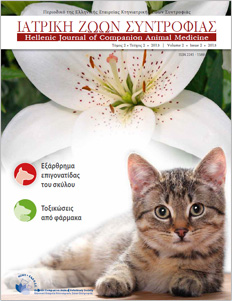> Abstract
The purpose of this study was the study of dogs with patellar luxation (PL) that were presented at the Companion Animal Clinic, School of Veterinary Medicine, Aristotle University of Thessaloniki, Greece during 2004 - 2010. Ninety-five dogs were included in the study. Among the information derived from the clinical examination records were breed, age, body weight, clinical signs upon presentation, site and grade of luxation, type of treatment and outcome of the dogs. Statistical analysis revealed that PL is observed more frequently in mixed breed (27.4%), small sized (61%) and female (52.6%) dogs. Regarding purebred dogs, PL has been more frequently diagnosed in Yorkshire Terriers, Poodles and Chihuahuas.










 PDF Download
PDF Download